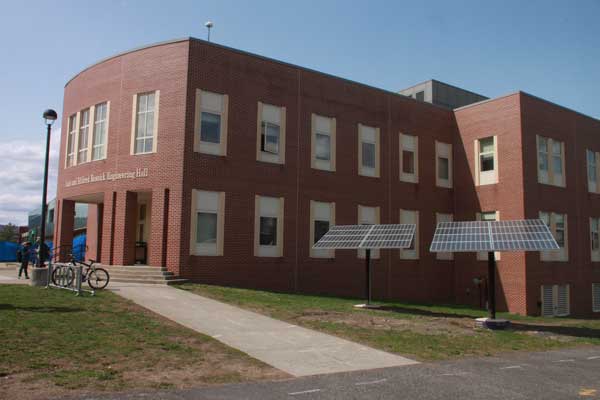
SUNY New Paltz recently installed new sets of solar panels outside of Resnick Engineering Hall to power the building, which is home to the university’s electrical and computer engineering programs. The building is attached to Wooster Science Building, which is scheduled to open in the coming Fall 2015 semester.
The new solar panels power Resnick Engineering Hall, New Paltz Energy Management Coordinator Brian Pine said. According to Pine, the installation was funded by materials leftover from other projects, as well as assistance from the university’s Facilities Operations team. Dean of Science and Engineering Daniel Freedman and Assistant Vice President of Facilities Management John Shupe collaborated to choose the location.
“[It is] a very observable, sunny spot,” Pine said.
According to newpaltz.edu, the new solar panels will generate about three kilowatts (kW) of power, which increases the campus’ current total accumulation of solar energy power to approximately 70 kW. In this news release, Pine said that he hopes students take notice of these new solar panels and are inspired by the university’s efforts to “go green.”
Campus Sustainability Coordinator Lisa Mitten praised the new solar panels alongside Pine, also citing their visibility as a major gain for the campus.
“The new array [of solar panels] on the ground next to Resnick is a great conversation starter,” Mitten said. “I hope that it’s kickstarting dialogue across campus about renewable energy.”
These new solar panels are part of New Paltz’s award-winning ongoing sustainable energy initiative, including previous installations of electric vehicle charging stations in the Elting Gym and Route 32 parking lots as well as solar panels on the roof of the university’s Athletic and Wellness Center.
Mitten elaborated on the university’s other efforts to initiate sustainable practices. She said New Paltz’s sustainability efforts consist of three objectives: energy conservation, energy efficiency and renewable energy. Her office works primarily on dialing back energy usage during the colder months, as well as scheduling lighting and air conditioning systems to eliminate wasteful cooling and lighting.
According to Mitten, the best strategy she and other sustainability experts on campus can employ to institute environmentally friendly policies is simple: to listen to faculty and students. This is a huge part of Mitten’s ongoing goals.
“Then, [we can] work with them on how to turn their own ideas into reality,” Mitten said. “What is needed to turn a seed idea into a reality? Who can the person reach out to on campus and off campus to support this interest? I strive to listen to what people are interested in and grow from there, rather than tell people what they should focus on.”
